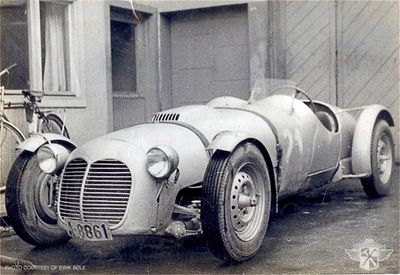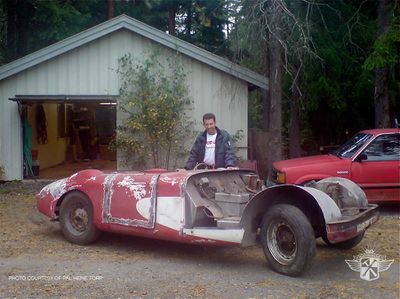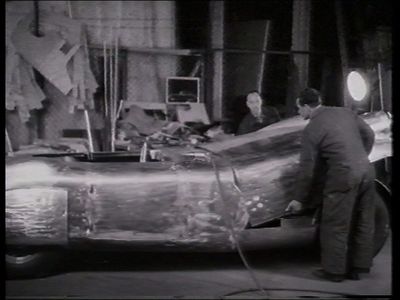Ralph Lysell's Rally



























Rally is a Norwegian built sports car designed by Ralph Lysell of Stockholm, Sweden. Rally was meant to be the first Norwegian produced sports car of the 1950s. It's creator, Ralph Lysell, was an eccentric industrial designer born in Stockholm, Sweden in 1907. He moved to the United States at age 16. Abroad he took night classes at Columbia University in New York, and in 1936 he entered the auto industry with a self designed futuristic streamlined car that he wanted to mass produce. The car never went into production, and it is not known exactly what happened. According to one story, the factory where the car was built was lost in a flood. Another story claims that the project ran out of money, while a third story claims that the american auto and aircraft industry were so terrified of Ralph's futuristic creation that they paid him to leave the country in 1938. After leaving the United States[1], Ralph went to Europe. He visited several European countries, and worked as a consulting engineer for companies such as Mercedes-Benz, Adler and BMW. In Germany, Ralph did also work as a test driver for Mercedes-Benz. Ralph was in Stockholm on a promotion tour for Mercedes when WWII broke out. He decided not to return to Germany, and settled down in Stockholm working as a industrial designer. In the beginning he worked as a designer for L.M. Ericsson. In 1941, while working for Ericsson, Ralph was involved in designing the initial design for the iconic Ericofon, and Ralph Åke Gösta Lysell and Knut Hugo Blomberg filed a patent on the design as assignors to Ericsson in October the same year. Ralph moved on, and established his own company called AB Industriell Formgivning where he took on design assignments from companies such as Volvo and Electrolux. In 1947 Ralph fled Sweden due to a failed business attempt that ended in a huge loss for its investors. He moved to Paris, France, where he managed to become a well known industrial designer as well.[2]
In 1949 Ralph moved to Oslo, Norway. It is not known why he moved to Oslo, but chances are big that he met his Norwegian wife while living in Paris. Ralph was also very interested in new materials, so it could also be the supply of Norwegian aluminum that brought Ralph to Norway. When Ralph came to Norway, he brought with him some sketches of a futuristic automobile in his luggage. After WWII there were import restrictions on cars and trucks in Norway. The desperate need for cars and trucks was considered a business opportunity for many Norwegian entrepreneurs at the time, and as Ralph was an engineer and an industrial designer with a background from the auto industry, he eyed an opportunity to produce and sell Norwegian made automobiles. He had plans for a range of cars including a sports car, a taxi cab, and a truck. Ralph started with the sports car. The sports car was called Rally, a name most likely made from Ralphs own name: RALph LYsell. January 17, 1951 the citizens of Norway were presented with Ralph's automotive plans in a story published in the Norwegian newspaper Aftenposten. The story was titled "Experienced Auto-Man Plans Norwegian Production of Taxi-Cabs". By then he had already started building the Rally prototype at Norwegian Aircraft Industries LTD at Fornebu. Fornebu was the main airport of Norway, located in Oslo. After a failed attempt of building an airplane in the late 1940s, Norwegian Aircraft Industries LTD were seeking new ventures, looking into the auto industry. Their craft was welding and shaping of aluminum, and during the period 1950 - 1951 at least four, but maybe even five cars were built at Norwegian Aircraft Industries LTD. Two or three of the cars were in-house projects led by three gentlemen named Kjeld W. Eriksen, Birger Hannisdal, and Oskar Skotvedt. In 1950, the trio even went to Earls Court, London to learn more about the auto industry. Ralph's Rally was built by Norwegian Aircraft Industries LTD at their facilities, but it was a project run and operated by Ralph.[3]
Ralph's low slung sports car featured a streamlined body made mostly from 3mm thick aluminum plates. Ed Håseth was one of the guys that worked on the car. In 2018 Terry Haaseth told Sondre Kvipt of Kustomrama that his dad went to Oslo after the war, around 1948; "He was sheet metalal worker, and ended up doing most of the sheet metal forming on the car."[4]
As the project progressed, some changes were done to the initial design of the car, and most notably is the more conventional headlights, the shape of the fenderskirts and the enlarged front wheel openings. Ralph's design sketches shows that he wanted to fit the Rally with a plexiglas bubble top. Ralph was very found of bubble tops, and the same cockpit design can be found on a boat and an airplane he designed as well. Ralph's sports car featured two gas fillers on each side of the rear deck that were operated by push-buttons on the gauge panel placed in the middle of the cockpit. He wanted to produce the body and chassis for the production cars in Norway. The engine blocks, clutches, transmissions and rear ends did Ralph plan to import from the United States. The prototype was built on a chassis designed by Ralph. The rear end, front suspension transmission and engine were taken from an American Ford or Mercury. According to the newspaper article, the Rally was powered by an english Ford flathead V-8 that had been hopped up from 95 to 160 horsepowers. The same story did also state that Ralph wanted to import the engine blocks, clutches, transmissions and rear ends from Germany or England. This was the case for the taxi cabs, but not the Rally. Later on, in April of 1951, the Norwegian television broadcaster NRK visited Ralph at Fornebu to document the event that was taking place on film. The movie clip is still around, and it shows the Rally powered by a Mercury flathead V-8 engine. The engine had been hopped up featuring dual carburetors. Due to the extensive usage of aluminum, the car weighted supposedly only 870 kg. The commentator in the movie mentions that the car will be fit with a plastic bubble before it will be shown to the public. The body for a Norwegian made race car called The Stousland Special, was handmade out of aluminum next to the Rally at Norsk Flyindustri in 1951 as well.[3]
Ralph was a visionary, and he told Aftenposten that he wanted to produce 15 Rally's in addition to the prototype in 1951. The reason was that he had already received 15 orders on the car from enthusiasts in Norway and Sweden. Ralph did also tell the journalist that he planned to start building the taxi-prototype later on the same year as well. The real production for the taxi cab was planned to start in 1952, and he wanted to produce 70 of these the first year. Ralph's taxi was designed especially for the conditions in Norway, and he wanted the selling price to be below 18,000 NOK. He wanted the taxi to be powered by an english Ford engine. Just as the Rally, the taxi engine would also feature dual carburetors. These carburetors were specially designed by Ralph, and they were constructed for efficiency and high acceleration in the city. A brand new steering mechanism would make the car very easy to steer and a special designed stabilizer would make the car tailored for the narrow and winded roads of Norway. As with the Rally, Ralph wanted to use as much Norwegian aluminum as possible in his taxi cab.[5]
Only one prototype of the Rally was built, and according to a story published in Teknikens Värld November 1953 Ralph abandoned his automotive dream to build an aluminum lifeboat called "Svelvik". Svelvik was designed so it couldn't tip or sink.[6]According to rumors, and there are many rumors about Ralph, the car was good for more than 200 kilometers per hour. Ralph eventually sold the Rally to Paul Wiencke. As there were problems getting the car through Norwegian inspection, it took some time before it could be driven legally on the streets. September 4, 1954 the Rally passed inspection, and it received its first set of Norwegian license plates. It received the chassis number "VDN 478". VDN, which stands for "VegDirektoratets Nummer", was a series of numbers created after WWII for homebuilt cars and trailers. According to the registration-title, the current owner was Jack Roar Rollve of Oslo, who actually worked for the government, inspecting cars. When the car passed inspection in 1954 it was still powered by a Mercury V8 engine, and it rolled on 6.00x16 inch wheels on all four corners. The total weight according to the registration-title was 1050 kg. A month later, on Ocotber 7, 1954, the car was sold to Willy Will Gundersen of Oslo.[3]
Johan Megaard bought the Rally in 1959. When Johan bough the car it was parked on a street in Oslo, and it was in need of some love and care. Johan began working on the car. He repainted it, but he never got it back on the road again, so in 1963 he sold it to his good friend Roger Glans of Halden, Norway. When Roger got the car the bubble top was missing, so he installed a rear window from a 1950 Studebaker as windshield and he made a soft top to go along with it. He did also install a pair of Jaguar bumpers along with taillights from a Volvo PV. Inspired by early Chevrolet Corvettes, the Rally was painted in a two-tone color combination before he got it back on the road again in 1964. Not satisfied with how the car handled on the road, Roger sold the Rally in 1968.[7] Early in the 1970s the car was taken out of traffic by its current owner Johan Johnsen. Kay Minge of Trøgstad, Norway owned the car for a while after Roger. Around 1980 Kay sold the car to Jan-Odd Jakobsen. Jan-Odd had heard rumors about an early Corvette in Østfold. While looking for the Corvette he stumbled across Minge's roadster, and he realized that he had found the "Corvette" he was looking for. He bought the car but sold it further to a guy from Nesodden, Norway after a while.[8] In 2007 Pål Heine Torp of Sarpsborg, Norway found the car advertised for sale. The listing was very anonymous, and Pål understood right away that this had to be a very special car, so he bought it only hours after he first saw the ad. Pål owned the car for about a year, and was able to trace much of the history of the old Norwegian sports car. When Pål became aware of the car's unique legacy, he decided to sell it off to an enthusiast willing to bring it back to its former glory. Pål sold the old sports car to Eirik Bøle of Asker, Norway in 2008. Eirik is a collector of Norwegian made automobiles, and amongst his collection is also the Stousland Special. After buying the car, Eirik started a thoroughly restoration back to how the car appeared on construction photos from 1951. With old paint peeling off the body, the car looked to be in a much worse condition then it actually was. It was free from rust, and due to the solid body made from 3mm thick aluminum plates, the body was in a very good condition. It had a little dent in the hood, but that was basically it. Eirik went over the driveline, brakes and mechanical parts and replaced broken or worn out parts. The body was straightened and cleaned up before Magnus Ahlqvist at Motorima Coachbuilding began constructing the missing bubble top for the car. The restoration was done after old photographs, but as no photos of the car with a bubble top has surfaced yet, and as nobody knows for sure wether or not the car ever received a bubble top, Eirik decided to have a top similar to the one found on the 1954 Pontiac Bonneville Concept Car made for the car. The bubble top and its framework was completed in January 2012, only days before the car was shown at and exhibit at DesignHall in Hägersten, Sweden honoring Ralph Lysell, the first industrial designer of Sweden. The exhibit runs from February 3 thru April 15, 2012, and at the exhibit, the Rally Special is shown in an almost completed bare aluminum version.[9]
Addendum
Most of the material in this article has been compiled, collected and provided by Eirik Bøle. After Eirik bought the car in 2008 he has spent countless hours researching the history of Ralp Lysell and the Rally sports car. Through his extensive research, he has been in touch with Ralph's family, historians and past owners.
Magazine Features
Veteran & Sportsbil 4:2008
Nostalgia 2 2009
Classic Motor July 2009
Fuel Issue 9
References
- ↑ Svenska Dagbladet 20 April 1945
- ↑ Svensk Industridesign - En 1900-Tallshistoria
- ↑ 3.0 3.1 3.2 Eirik Bøle
- ↑ Terry Haaseth
- ↑ Aftenposten 14. Januar 1951
- ↑ Teknikens Värld November 1953
- ↑ Nostalgia 2 2009
- ↑ Jan-Odd Jakobsen
- ↑ DesignHall
Did you enjoy this article?
Kustomrama is an encyclopedia dedicated to preserve, share and protect traditional hot rod and custom car history from all over the world.
- Help us keep history alive. For as little as 2.99 USD a month you can become a monthly supporter. Click here to learn more.
- Subscribe to our free newsletter and receive regular updates and stories from Kustomrama.
- Do you know someone who would enjoy this article? Click here to forward it.
Can you help us make this article better?
Please get in touch with us at mail@kustomrama.com if you have additional information or photos to share about Ralph Lysell's Rally.
This article was made possible by:
SunTec Auto Glass - Auto Glass Services on Vintage and Classic Cars
Finding a replacement windshield, back or side glass can be a difficult task when restoring your vintage or custom classic car. It doesn't have to be though now with auto glass specialist companies like www.suntecautoglass.com. They can source OEM or OEM-equivalent glass for older makes/models; which will ensure a proper fit every time. Check them out for more details!
Do you want to see your company here? Click here for more info about how you can advertise your business on Kustomrama.

































